 |
 |
 |
| |
COPD Rate 7% in Global HIV Cohort--Half With COPD Never Smoked
|
| |
| |
20th International AIDS Conference, July 20-25, 2014, Melbourne
...."appears to relate strongest to smoking and aging.....We are likely to see more COPD as PLWH continue to age..... Also of interest, we note that of the 67 with COPD, almost half reported lifelong nonsmoking..... HIV also increases COPD risk "
". ......The main COPD risk factor is cigarette smoking......HIV also increases COPD risk.
....... Other known risk factors are indoor air pollution such as using wood to cook and heat the home, and alpha-1-antitrypsin deficiency, a genetic condition most common in northern Europeans......However, multiple observational studies find that HIV is an independent COPD risk factor, even when adjusting for high prevalence of cigarette smoking in PLWH. ......Mechanisms not clear--?inflammation due to HIV ?lung infections due to HIV ?oxidative stress due to HIV ?ART itself, as two studies have suggested
.....COPD is a lung disorder characterized by emphysema (destruction of lung tissue), airway inflammation, and airway fibrosis. .......This leads to airways that are collapsible and narrowed. As a result, air becomes trapped in the lung and the chest becomes hyperinflated, especially with activity.
.....This causes patients with COPD to suffer from shortness of breath and limits their ability to exert themselves......COPD is also a major (and rising) global public health problem.
Between 1990 and 2010, COPD moved up to become the current 3rd leading cause of death in the world."
Mark Mascolini
Prevalence of chronic obstructive pulmonary disease (COPD) stood at 7% in a cross-sectional study of 1026 START trial participants across the globe [1]. COPD prevalence proved 4-fold higher in current smokers than in former smokers, but almost half of people with COPD reported never smoking. The study group had a median age of 36, and only 1% injected drugs.
START, the landmark treatment-interruption trial, has a Pulmonary Substudy. Researchers working on that substudy noted that COPD is the third-leading cause of death across the world and that HIV infection ranks as an independent COPD risk factor. They observed that COPD prevalence has ranged from 3% to 21% in diverse HIV groups, but those cohorts are typically small and usually in North America or Europe.
The COPD analysis involved 1026 adults 25 or older and naive to antiretrovirals when they entered START and had their lung function tested. No one in the substudy used asthma drugs. After inhaling albuterol/salbutamol, they performed standardized spirometry. The investigators figured how many had COPD, defined as forced expiratory volume in 1 second/forced vital capacity (FEV1/FVC) ratio below the predicted 5th percentile.
Study participants came from 80 sites in 20 countries and all had an initial CD4 count above 500. Ninety-one participants lived in the United States, 103 in Asia, 191 in Mexico or South America, 313 in Europe, Israel, or Australia, and 328 in Africa. Overall, 29% of participants (64% in Africa) were women, 38% were black, and 34% were white. Median age stood at 36 (interquartile range [IQR] 30 to 44), median CD4 count at 648 (IQR 582 to 767), and median time since HIV diagnosis at 1.2 year (IQR 0.4 to 3.5). Almost half of the study group (49%) became infected with HIV during sex between men and only 1% while injecting drugs. Most study participants (61%) never smoked, 28% were current smokers, and 11% were former smokers. Africans included the highest proportion of never-smokers, 80%.
Overall COPD prevalence stood at 6.8%. Prevalence was highest in Europe, Israel, and Australia (9.1%), followed by the US (8.2%), Africa (7.8%), Mexico and South America (3.3%), and Asia (2.0%) (P = 0.03). COPD prevalence was more than twice higher in people in the highest age quartile (older than 44, 9.2%) than in the youngest quartile (25 to 30, 3.9%). Prevalence in the 31-to-36 group stood at 6.7% and in the 37-to-44 group at 7.6%. But COPD rate did not differ significantly by age (P = 0.13).
COPD prevalence was similar in people who never smoked (5.3%) and former smokers (2.7%) but much higher in current smokers (11.8%) (P < 0.001). Still, nearly half of study participants with COPD (47%) reported being lifelong nonsmokers.
Multivariate linear regression analysis identified three independent predictors of lower (worse) FEV1/FVC ratio: older age (P < 0.0001), more smoking pack-years (P < 0.0001), and region (P = 0.01). The START team suggested that variability by region could reflect nonsmoking factors such as exposure to fuel exhaust, smoke, or dust. Gender did not affect FEV1/FVC ratio in this analysis.
The researchers proposed that regional differences in COPD could partly reflect regional differences in gender and smoking, plus environmental factors. They see a need to train HIV clinicians in COPD screening, diagnosis, and management. The START team predicted that as people live longer with HIV infection, "COPD will emerge as a major comorbidity."
Reference
1. Kunisaki K, Niewoehner D, Collins G, et al. AIDS 2014. Chronic obstructive pulmonary disease (COPD) in a large international cohort of HIV-infected adults with CD4+ counts >500 cells/mm3. 20th International AIDS Conference. July 20-25, 2014. Melbourne. Abstract WEAB0104.
------------------------------

Smoking cessation critical to prevention of COPD in PLWH
We are likely to see more COPD as PLWH continue to age


I want to start by providing some background regarding COPD, which stands for chronic obstructive pulmonary disease.
COPD is a lung disorder characterized by emphysema (destruction of lung tissue), airway inflammation, and airway fibrosis.
This leads to airways that are collapsible and narrowed. As a result, air becomes trapped in the lung and the chest becomes hyperinflated, especially with activity.
This causes patients with COPD to suffer from shortness of breath and limits their ability to exert themselves.

COPD is also a major (and rising) global public health problem.
Between 1990 and 2010, COPD moved up to become the current 3rd leading cause of death in the world.
Still higher than HIV/AIDS, but as you know, HIV also increases risk for diseases such as coronary disease (#1), pneumonia (#4), and lung cancer (#5).

HIV also increases COPD risk.
The main COPD risk factor is cigarette smoking. Other known risk factors are indoor air pollution such as using wood to cook and heat the home, and alpha-1-antitrypsin deficiency, a genetic condition most common in northern Europeans.
However, multiple observational studies find that HIV is an independent COPD risk factor, even when adjusting for high prevalence of cigarette smoking in PLWH. Mechanisms not clear--?inflammation due to HIV ?lung infections due to HIV ?oxidative stress due to HIV ?ART itself, as two studies have suggested
Prevalence highly variable, but all single-center, largest n=316.

We conducted a pulmonary substudy nested within the larger START trial. START is designed to compare the effects of immediate vs deferred ART on AIDS and non-AIDS events in those naïve to ART, with CD4>500.
For our substudy we excluded those <25 due to our larger aim of comparing lung function decline over time-those <25 may actually gain lung function. Also excluded asthma, due to lung function tests variability/unreliability in asthma, and contraindication to either spirometry or to use of albuterol/salbutamol.
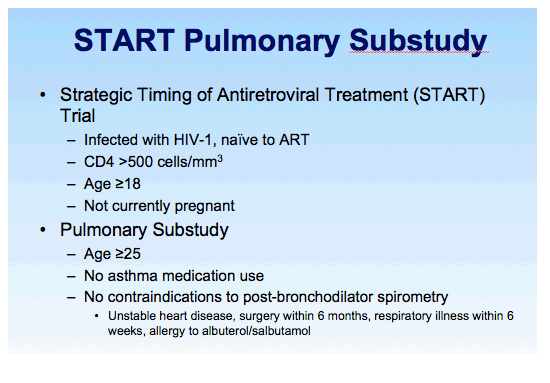
Spirometry performed by trained/certified site technicians using portable spirometer devices.
These portable spirometer devices are well validated against more formal spirometry
Every test report was QC reviewed by me. Tests that did not meet quality criteria were excluded from this cross-sectional analysis.
Tests provide FEV1-how much air one can exhale in 1 second
FVC-how much air can be exhaled in total
FEV1/FVC ratio-most of us should exhale most of our air within 1 second
Persons with COPD have smaller airways, this slowing the ability of the lungs to exhale air.
COPD defined as FEV1/FVC <5th percentile of predicted.
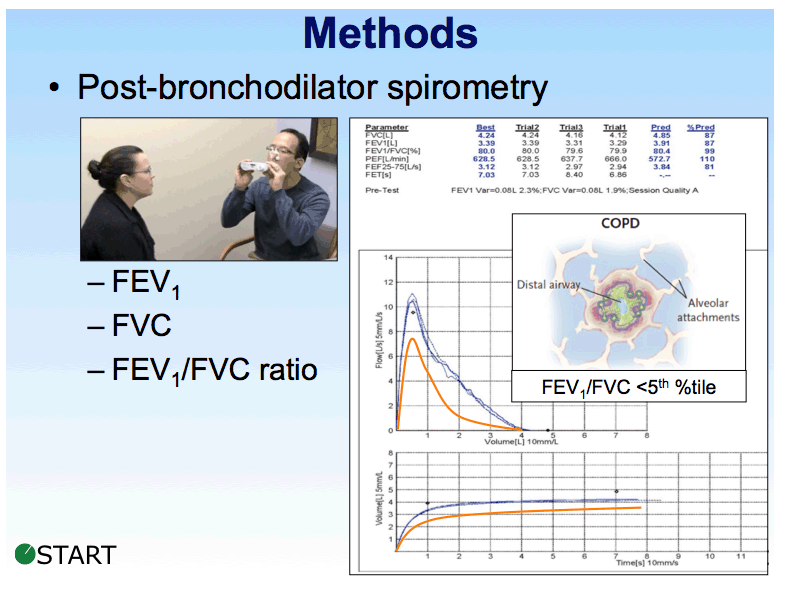
Enrolled 1026 participants from 80 sites in 20 countries. Achieved what I think is an excellent globally representative sample, unique compared to previous studies of COPD in HIV.
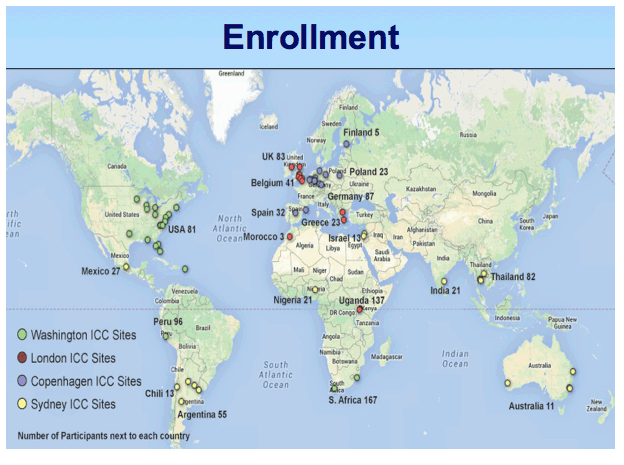
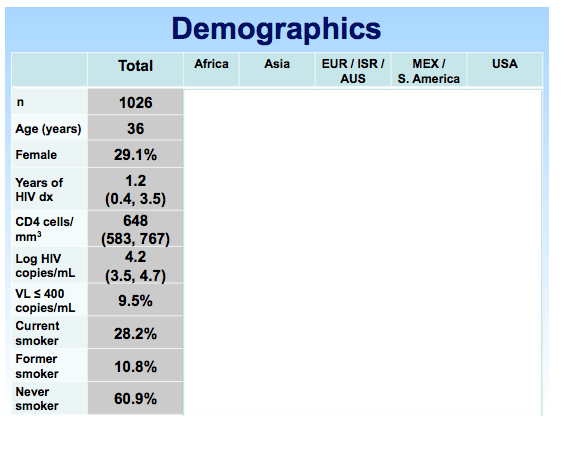
Fairly young with a median age of 36 years, almost 30% female, recent diagnosis, almost 30% active smokers.
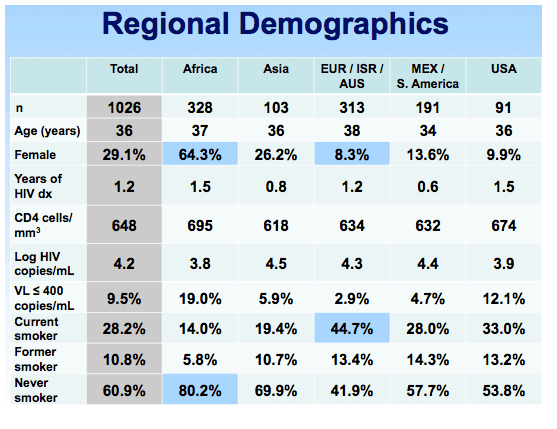
There are of a lot of data here, but I want to focus your attention on the observation that demographics varied by region
Particularly in gender and smoking status.
For example, in Africa, we mostly enrolled women who never smoked in their lives.
In Europe, we mostly enrolled men who were frequently current or former smokers.
These differences will be relevant to upcoming slides of COPD prevalence.
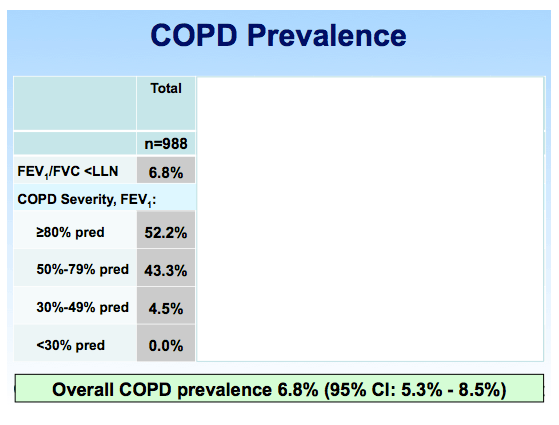
Of the 1026 participants, spirometry quality was good in 988 (96.3%)
COPD was present in 6.8%
This is within the range reported in the previously cited publications.
Most COPD was mild or moderate in terms of the degree of FEV1 impairment (these are generally used COPD cutpoints for FEV1 impairment).
Ranged from 2% in Asia to 9.1% in Europe/Israel/Australia.

COPD also varied by smoking status and age. I am showing you %/ages here now and I think these are the more important data from our analyses.
Among current smokers, nearly 12% had COPD
Among the highest age quartile (>44 y/o), 9.2% had COPD.
Also of interest, we note that of the 67 with COPD, almost half reported lifelong nonsmoking.
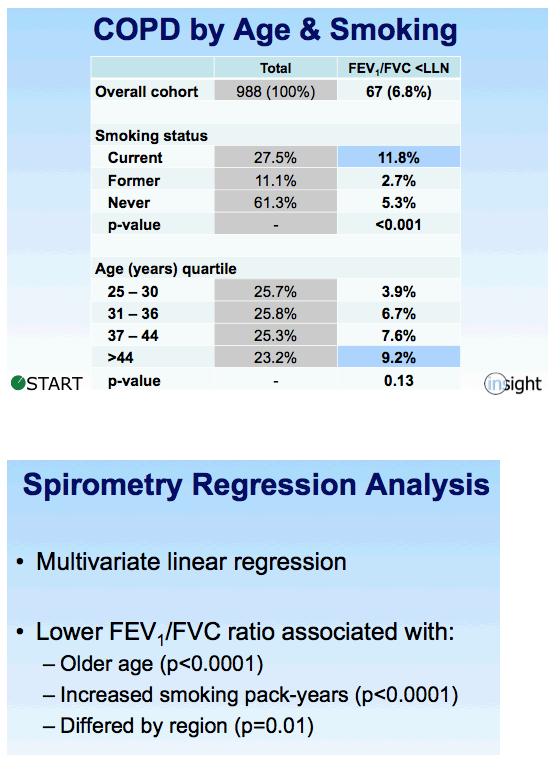
To attempt to understand whether region, smoking, and/or age was driving the observed COPD, we conducted multivariate linear regression with FEV1/FVC ratio as the dependent variable.
We found that older age and pack-years of smoking has strong association with lower (worse) FEV1/FVC ratio.
Gender did not have an effect, but regions had significantly different beta coefficients.
The variability by region might be related to non-smoking factors such as environmental exposures such as biomass fuel use and occupational dust/smoke exposure. We did not collect such data, but are in discussions about how to potentially collect such data, particularly from sites in the developing world.
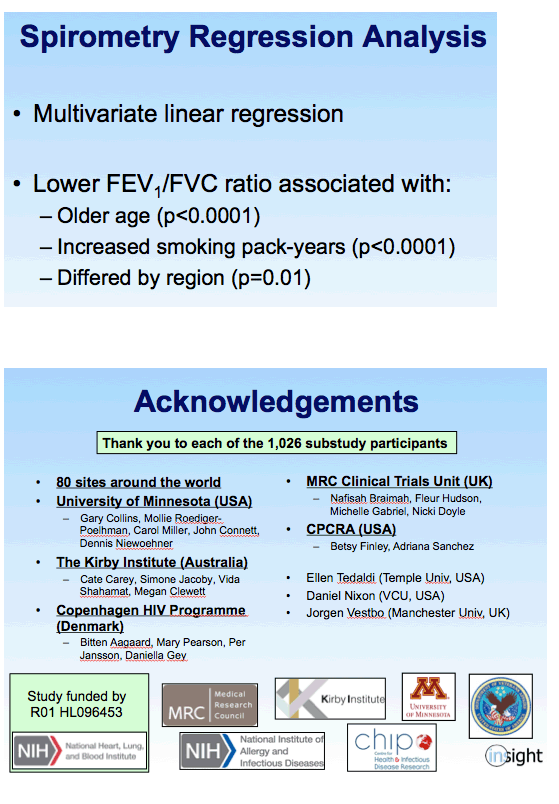
|
| |
|
 |
 |
|
|